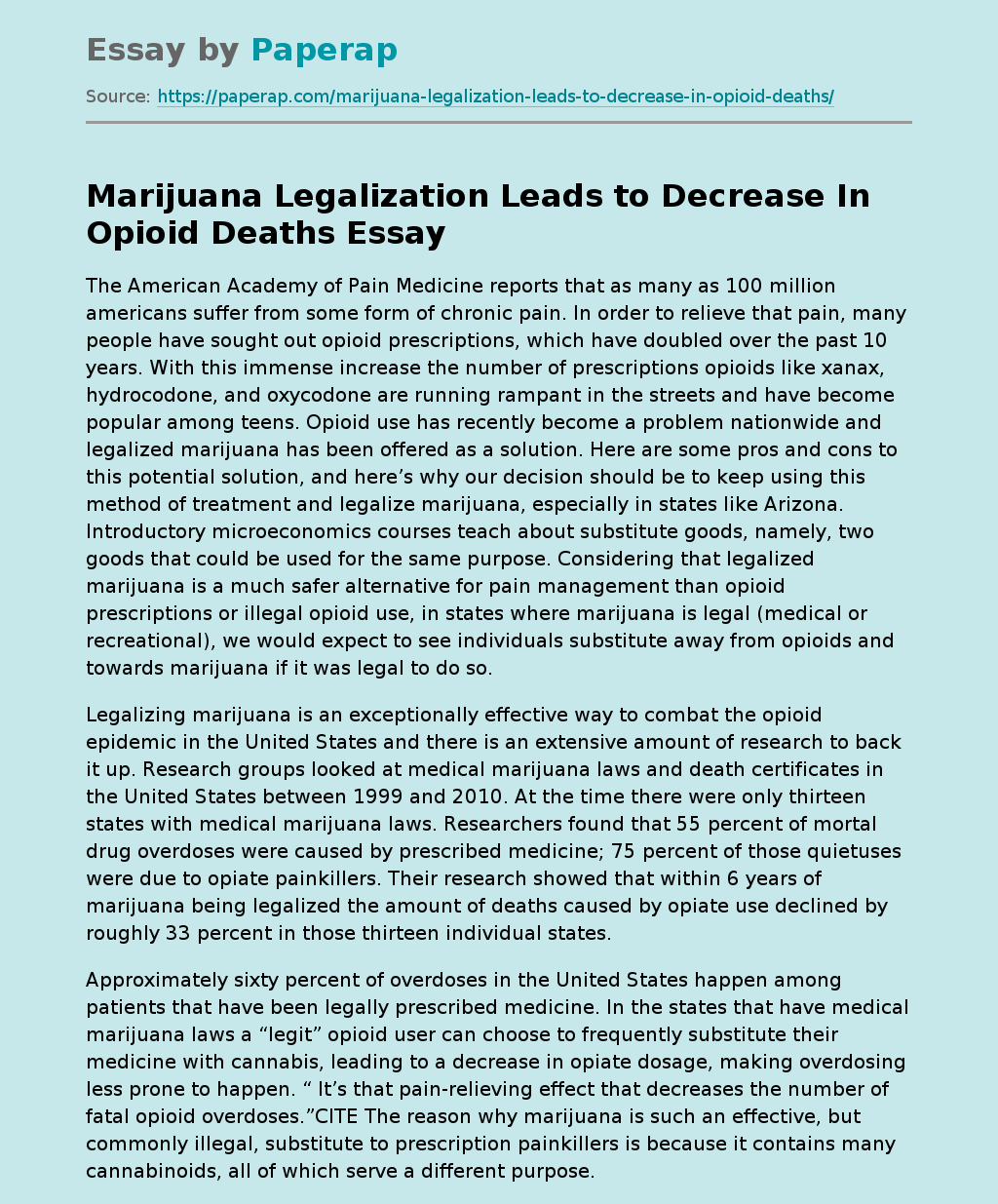Marijuana Legalization Leads to Decrease In Opioid Deaths
The American Academy of Pain Medicine reports that as many as 100 million americans suffer from some form of chronic pain. In order to relieve that pain, many people have sought out opioid prescriptions, which have doubled over the past 10 years. With this immense increase the number of prescriptions opioids like xanax, hydrocodone, and oxycodone are running rampant in the streets and have become popular among teens. Opioid use has recently become a problem nationwide and legalized marijuana has been offered as a solution.
Here are some pros and cons to this potential solution, and here’s why our decision should be to keep using this method of treatment and legalize marijuana, especially in states like Arizona. Introductory microeconomics courses teach about substitute goods, namely, two goods that could be used for the same purpose. Considering that legalized marijuana is a much safer alternative for pain management than opioid prescriptions or illegal opioid use, in states where marijuana is legal (medical or recreational), we would expect to see individuals substitute away from opioids and towards marijuana if it was legal to do so.
Legalizing marijuana is an exceptionally effective way to combat the opioid epidemic in the United States and there is an extensive amount of research to back it up. Research groups looked at medical marijuana laws and death certificates in the United States between 1999 and 2010. At the time there were only thirteen states with medical marijuana laws. Researchers found that 55 percent of mortal drug overdoses were caused by prescribed medicine; 75 percent of those quietuses were due to opiate painkillers.
Their research showed that within 6 years of marijuana being legalized the amount of deaths caused by opiate use declined by roughly 33 percent in those thirteen individual states.
Approximately sixty percent of overdoses in the United States happen among patients that have been legally prescribed medicine. In the states that have medical marijuana laws a “legit” opioid user can choose to frequently substitute their medicine with cannabis, leading to a decrease in opiate dosage, making overdosing less prone to happen. “ It’s that pain-relieving effect that decreases the number of fatal opioid overdoses.”CITE The reason why marijuana is such an effective, but commonly illegal, substitute to prescription painkillers is because it contains many cannabinoids, all of which serve a different purpose. Research suggests that in marijuana there are 4 main cannabinoids that actively help relieve pain. Those cannabinoids are Delta-9 Tetrahydrocannabinol (THC), Cannabidiol (CBD), Cannabinol (CBN), and Tetrahydrocannabivarin (THCV). When you intake marijuana those 4 cannabinoids work together to relieve pain throughout your body. Often these pain relieving effects are stronger than that of opioids with dangerous side effects. CBD is the most potent pain reliever and you can even smoke CBD extract in the form of an oil to maximize its effects.
States that made access to marijuana easier saw a further decrease in opioid use and deaths. Oregon, Alaska, Colorado, and Washington switched from only medical use to recreational use and experienced a significant drop in opiate prescriptions. “We saw a 9% or 10% reduction (in opioid prescriptions) in Colorado and Oregon,’ Wen said. ‘And in Alaska and Washington, the magnitude was a little bit smaller but still significant.’ States that authorized recreational use of marijuana saw an extra 6.38% drop in opiate prescriptions covered by Medicaid when compared with states that only allowed medical cannabis use.
“States that permitted medical dispensaries — regulated shops that people can visit to purchase cannabis products — had 3.742 million fewer opioid prescriptions filled per year under Medicare Part D, while those that allowed only home cultivation had 1.792 million fewer opioid prescriptions filled per year.” CITE. Even with the lowest number of prescriptions not being filled this is still a huge impact and has undoubtedly saved a lot of lives. The researchers saw that there was a 14.5% drop in opioid use when dispensaries are available and a 7% drop in use when only cultivation was allowed. Marijuana laws also caused a drop in the type of opiates that are used. States that passed marijuana laws had 20.7% fewer morphine prescriptions, 17.4% decrease in hydrocodone prescriptions, and fentanyl saw an 8.5% decrease.
Marijuana Legalization Leads to Decrease In Opioid Deaths. (2021, Dec 15). Retrieved from https://paperap.com/marijuana-legalization-leads-to-decrease-in-opioid-deaths/

